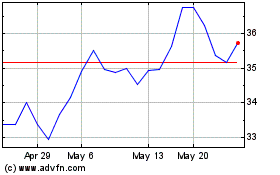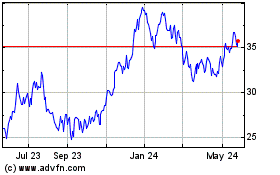Asian Shares Slide on Slumping Oil Prices
11 August 2016 - 2:00PM
Dow Jones News
Shares in Asia were broadly down early Thursday as a rise in
U.S. crude-oil inventory and expanding production in Saudi Arabia
sent oil prices lower.
Australia's S&P/ASX 200 was trading down 1.0%, while
Singapore's Straits Times Index fell 0.6% and South Korea's Kospi
lost 0.3%. Japan's market was closed for a holiday Thursday.
Overnight, U.S. crude-oil prices fell 2.5% to $41.71 a barrel,
after the Energy Information Administration said inventories of
crude rose in the week ended Aug. 5, contrary to expectations of a
decline. Crude oil was trading down a further 1% in early Asian
trade Thursday.
Separately, Saudi Arabia, the world's largest oil producer,
expanded production. The move "suggests a pragmatic effort to
maintain export revenues to pay the bills and a determination to
maintain market share," said Tim Evans, a Citi Futures analyst.
Among commodities-linked stocks in Australia, Rio Tinto Ltd. was
last down 0.8% at A$49.57, while Fortescue Metals Group lost 1.1%
at A$4.53.
The developments in oil markets overshadowed another rate cut in
the region.
New Zealand's central bank on Thursday cut the official interest
rate by a quarter of a percentage point to a record low of 2.00%,
indicating further reductions are likely to push consumer-price
inflation higher and tame a strong New Zealand dollar.
"The market had already priced in a rate cut and there was
sufficient speculation that a 50-basis-point cut was on the cards,"
said Alex Furber, a senior client services executive at CMC
Markets.
The disappointment pushed the New Zealand dollar 1% higher
against the U.S. dollar in morning Asian trade. The Kiwi has risen
6% against the greenback so far this year.
Elsewhere, the Bank of Korea kept its base rate unchanged for a
second straight month, as widely expected. The South Korean central
bank held the benchmark seven-day repurchase rate steady at a
record-low 1.25% on Thursday.
"Better fundamental data is likely to have prompted the BOK to
employ a wait-and-see approach," said Dwyfor Evans, head of
macro-strategy for Asia Pacific at State Street Global Markets.
Meanwhile, China's banking regulator Wednesday cut the ratio of
bad loans at commercial banks in the second quarter from
preliminary data it released last month.
This helped in part to support mild gains in the Shanghai
Composite Index, which was last up 0.3%, though the rise was capped
following the market's recent strength.
"There are no real factors that should sustain a continued
rally," said Fang Yan, an analyst at Guosen Securities. With the
index already over the 3000-point mark, it shouldn't move very much
beyond that for now, he said.
In currencies, China's central bank strengthened the yuan fixing
by its biggest margin since June, moving the benchmark for trade
against the dollar to 6.6255 from Wednesday's 6.6530, translating
to a 0.4% appreciation of the yuan. The adjustment followed the
overnight fall in the U.S. dollar index.
The dollar is weakening as the market is now pricing in just a
12% chance of a rate increase in September by the U.S. Federal
Reserve, down from 15% earlier, according to Fed Fund futures price
data from CME.
Jenny Hsu, Riva Gold, Kate Geenty, Grace Zhu, Kwanwoo Jun and
Ewen Chew contributed to the article.
Write to Kenan Machado at kenan.machado@wsj.com
(END) Dow Jones Newswires
August 10, 2016 23:45 ET (03:45 GMT)
Copyright (c) 2016 Dow Jones & Company, Inc.
Fortescue Metal (QX) (USOTC:FSUGY)
Historical Stock Chart
From Nov 2024 to Dec 2024

Fortescue Metal (QX) (USOTC:FSUGY)
Historical Stock Chart
From Dec 2023 to Dec 2024
